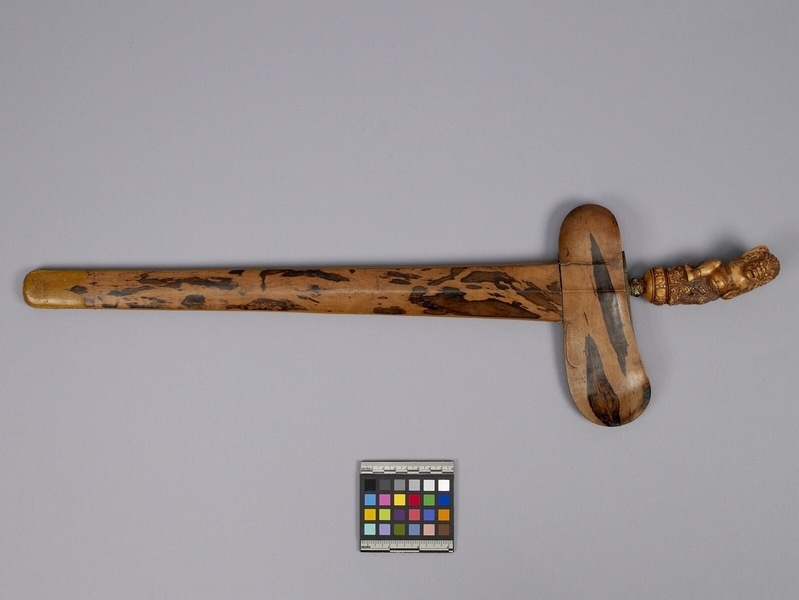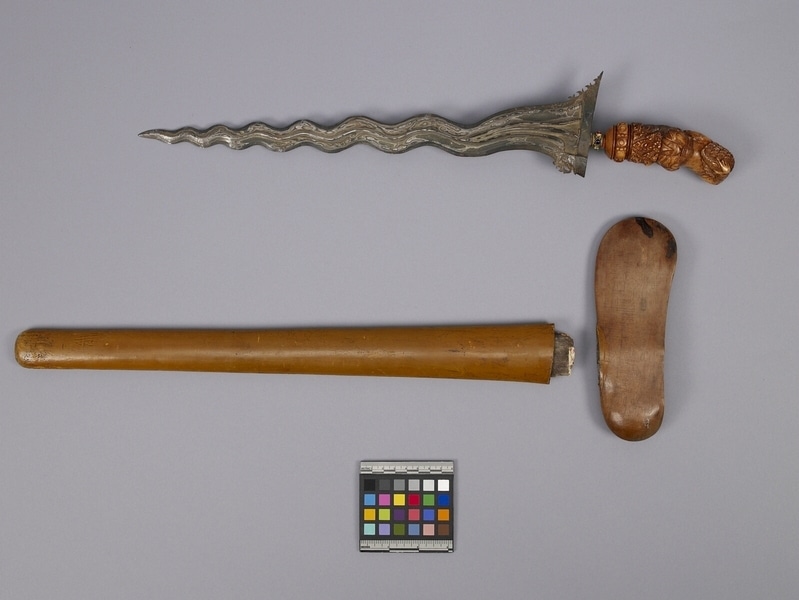Sword Item Number: Ib263 a-c from the MOA: University of British Columbia


Description
Metal kris with a curved, damascene blade (part a). Upper portions near the hilt are carved. The hilt is dark yellow ivory carved in the form of a demon with his right arm grasping a dagger behind the head and his left hand at his side holding up a thumb and two fingers. His right leg is turned around backwards and his left leg is straight. Figure is sitting on a carved stool. The blade is fixed into the hilt by a gilded ornamental ring containing five glass stones: two red, two blue, and one clear. One side of the wood sheath (parts b-c) has natural dark blotches while the other side is plain.
History Of Use
The magical powers of a kris established the authority of a prince. Puska-krisses were sacred heirlooms and were treated with the highest regard. Sometimes sacrifices were made to these krisses to add to their magical powers.
Cultural Context
Traditional men's dress and weapon.
Iconographic Meaning
The wavy blade depicts the mystical snake, Naga, in a state of motion, which provides a magical force. The demonic figure on hilt is used to drive away evil spirits. The kris as a whole is a symbol of authority, with its value and importance increasing with the number of waves in the blade.
Narrative
Collector obtained object from dealer in London, 1970.
Item History
- Made in Bali, Indonesia
- Collected during 1970
- Owned by Wilhelm Helmer before March 9, 1977
- Received from Wilhelm Helmer (Seller) and Museum of Anthropology Donations Fund (Funding source) on March 9, 1977
What
- Name
- Sword
- Identification Number
- Ib263 a-c
- Type of Item
- sword
- Material
- wood, ivory, metal and glass
- Manufacturing Technique
- carved, forged and polished
- Part A
- height 9.2 cm, width 51.7 cm, depth 5.7 cm
- Part B
- height 19.3 cm, width 6.9 cm, depth 3.0 cm
- Part C
- height 5.4 cm, width 48.4 cm, depth 2.7 cm
- Overall
- height 19.3 cm, width 64.3 cm, depth 5.7 cm
Who
- Culture
- Balinese
- Previous Owner
- Wilhelm Helmer
- Received from
- Wilhelm Helmer (Seller) and Museum of Anthropology Donations Fund (Funding source)
Where
- Holding Institution
- MOA: University of British Columbia
- Made in
- Bali, Indonesia
When
- Collection Date
- during 1970
- Ownership Date
- before March 9, 1977
- Acquisition Date
- on March 9, 1977
Other
- Item Classes
- metalwork
- Condition
- fair
- Accession Number
- 0367/0005 a-c